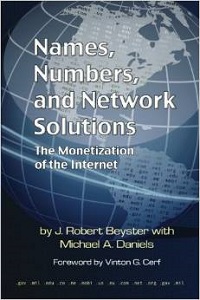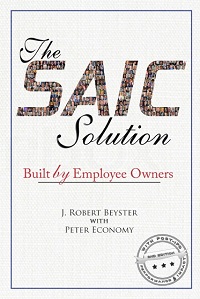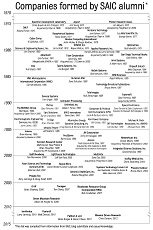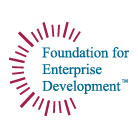Thank you for your title ideas — there are some good ones. If you think of any more, please send them along. I think it’s time for me to decide on a prize for the best idea.
This week we are working on creating a list of SAIC “turning points,” that is, a time (or period of time) when a conscious decision was made in the company to do things differently, and the company turned to make it happen. For example, our participation in the America’s Cup led to the realization by me that PR was not a bad thing, but instead that PR could bring good people and good business to SAIC. What are your key turning points in SAIC history — from the company’s founding, until I left in 2004 — and how did these turning points impact the company and employees, both in the short term and long term?
Click on the comments link to share your thoughts.
- Bob
Here are my responses to previous weeks’ comments:
Pam Peters (Week 14): I seem to remember two ethics committees, an employee ethics committee and a board of directors ethics committee. Both committees were very instrumental in responding to situations. There was also a hotline which allowed employees to report unethical behavior anonymously if they preferred. These vehicles, and probably others, played a key role in maintaining the high ethical standards of the company.





Hello Bob,
Norma and I have had a in-home contest for the book’s title. My suggestion is:
Selfless Creation of Success.
Norma’s suggestion is: Multifarious Movements of SAIC.
Jim & Norma
ISSAIC is a great informative internal website. As ISSAIC grew and evolved in parallel with our business growth. It continues to be the bestnternal resource in the company.
The winning of CHCS, which to that time was the largest single contract that SAIC had won and signaled an era of rapid growth in employees.
The purchase of Bellcore (now Telcordia) was a turning point, because SAIC was introduced to a much more product centric culture. In addition, Telcordia was primarily involved in business activities with major Telephony Service Providers. SAIC improved its position in the commercial market as a result.
Hello Dr. Beyster,
“For the Love of Science”
SAIC had great employees, working with them was inspirational. I had the honor to work with Vic Verbinski (and others), on projects including cleaning up Hanford and developing the VACS. This was contract work that lasted for six years. And, every moment was fantastic.
I started out in Sylvia Kaliss’ graphics department in Building E, drafting, making posters, publishing broshures, and editing the underground newsletter “Newsworth-E”. As I worked more closely with the scientists I was inspired to help them in the lab.
When I was assembling the RTR-3 products with Tom Novacek and Jim Winso, I was filmed on Rod Luck’s news interview with SAIC in 1996 (assembling).
As a temporary employee that did not recieve the stock option benefit, I realized that something else besides moneymaking was keeping me there, and it was a once in a lifetime opportunity, to be involved with such a technically talented, brilliant, competent, and easy to work with group. God only knows if such a masterpiece can be assembled again.
Thank you for all of your inspiration,
Kevin Collins.
P.S. I still have several copies of the Newsworth-E newsletter from April 1991 to December 1993.
Hello Bob,
The introduction of the stock bonus plan (ESOP) was a turning point in SAIC’s early history. As I mentioned in my note of week 12, the stock bonus plan brought sufficient cash to SAI to eliminate the need for occasional stock sales to outside investors, and thereby set the stage for your decision to build an employee-owned company.
Best regards,
Charlie
Early adoption of the CMM methodologies and processes. This made our solutions even better and provided a construct for us when proposing our solutions to customers.
Hi Bob,
I wanted to mention two key milestone turning points: the EPRI work and the Egyptian program.
When you hired Dr. Robert Erdman, then me six months later in 1973, Bob established the Palo Alto office and initiated SAI’s work in nuclear reactor safety, risk assessment and thermal-hydraulics. This work was initiated with EPRI, and we later performed work with the NRC. Eventually, Bob had the largest energy group in the corporation, and we had the best team of scientists/engineers in commercial nuclear reactor safety. The Palo Alto office (which later became the Los Altos Office) and our office in El Segundo (later became Hermosa beach and then Torrance) had many contracts in this area, and we were leaders in nuclear reactor safety. The Group later expanded into other areas such as fossil, ocean thermal energy conversion, and combustion, and an experimental lab in Palo Alto was established where we conducted extensive experimental thermal-hydraulic testing and computer code validation. Bob Erdman and EPRI were the turning points for SAIC breaking into the energy field, and in particular the nuclear. I believe this is very critical since it helped to establish SAIC with EPRI, NRC and DOE as a leader in the Energy filed. Other groups were subsequently formed which pursued nearly all aspects of energy.
The initial Egyptian win in 1995 demonstrated that we can successfully conduct international business if we understand the culture, the customer and have close and frequent customer communication. This, coupled with strong performance and customer trust, has allowed continuation and growth of this business line for almost 12 years. The Egyptian success also enabled the Range business to continue, after the loss of the Israeli job, slow down of NTC business, and losses on the LATR program.
Best regards,
Telal
Titles are very difficult. I remember being a little frustrated one day and as I was sitting around feeling sorry for myself I thought: Who’s The Boss Around Here? Then I remembered: Your The Boss.